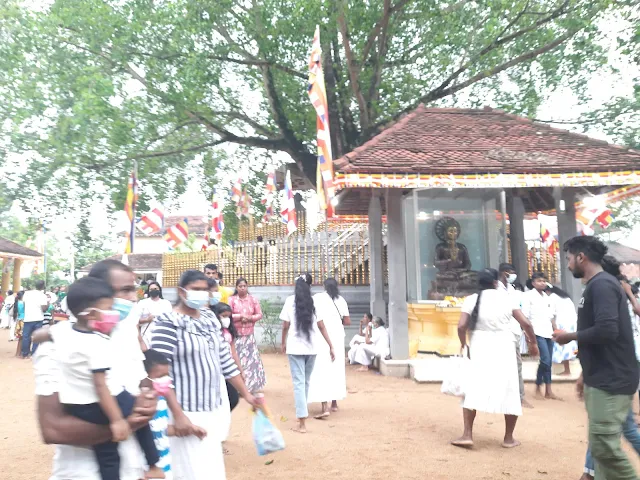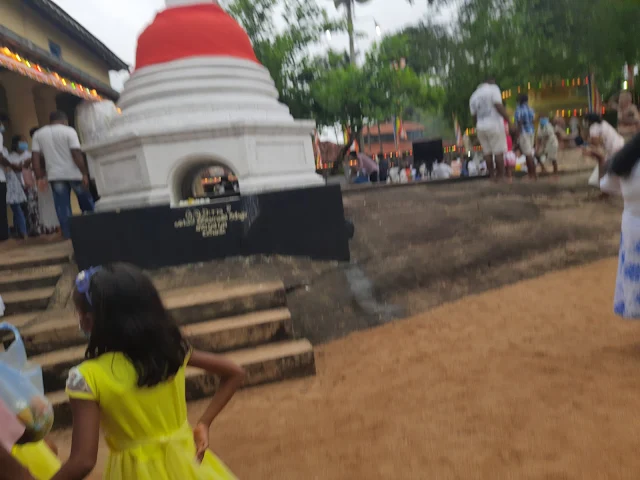The Royal Temple of historic Attanagalla Vihara
The Attanagalla Raja Maha Vihara was built by king Gotabhaya during 249-262 AD. It was later reconstructed by king Upatissa ( 365-406 AD)
Attanagalla is a small town located in the Gampaha District, Western Province , Sri Lanka. Attanagalla borders the Kegalle district in the Sabaragamuwa province. The picturesque village of Attanagalla is situated on the west bank of the Attanagalu Oya.
Attanagalla is well-known in the country due to two reasons.
- historically: due to the Attanagalla Raja Maha Vihara
- politically : The hometown of the Bandaranayakes
- Late Mr. S.W.R.D. Bandaranayake (prime minister)
- Late Mrs. Sirimawo Bandaranayake
(First woman prime minister of the world)
-Mrs. Chandrika Bandaranayake
(First woman executive president of Sri Lanka)
-Late Mr. Anura Bandaranayake
(Speaker - Sri Lanka Parliament)
👉
Attanagalla Raja Maha Vihara can easily be reached from Colombo- Kandy highway. The temple is located on the Nittambuwa - Hanwella road ( 6km. from Nittambuwa). The temple can also be reached from Pasyala.
Rev. Pannila Ananda Thero
The Chief incumbent of Attanagalla Rajamaha Vihara is Rev. Pannila Ananda Thero ; he is also the chief incumbent of Houston Buddhist Vihara, USA. Pannila Ananda Thero has been rendering a yeoman service to the community in Attanagalla as well as the whole nation. The Vihara has developed in leaps and bounds due to the Thero's dedication and hard work. His great service needs to be explained on a separate page. The Thero is a true son of the soil.
Traveler Sajendra, Youtube Channel
👪
The historical background of Attanagalla has been under debate for a long time. The blogger's intention here is not to get involved in any such aged old debate. I would like to leave it to historians or those who are interested in it.
👪
It is really interesting to read about the legends associated with the Attanagalla Raja Maha Vihara.
All the legends related to Attanagalla Raja Maha Vihara centers round the most pious King Sirisangabo (251-253 AD). He is known as a Bodhisattva (One who fulfils paramita in the samsaric journey of life in order to attain enlightenment)
✋
The Attanagalla Raja Maha Vihara is unique because it is the only Buddhist place of worship in Sri Lanka where a Bodhisatva fulfilled Dhana Paramita.
The story of King Sirisangabo. Sangabodhi (Sirisangabo) , Gotabhaya and Sangatissa were three friends. They were on their way to Anuradhapura to serve the king Vijaya. While the three friends were passing Thisawewa, a blind Wiseman who dwelt in a hut by the road exclaimed to hear their footsteps: "The earth bears these three kings." Only the last one to follow the two friends , Gotabhaya , heard this. He quickly approached the blind man and insisted "Pray tell me, whose reign will last long?" The answer was "The last one's my lord." Having heard this most unexpected prophesy, Gotabhaya quickly joined the other two. He determined not to reveal anything about the prophesy to the two friends. Thus, the three friends finally reached Anuradhapura as expected and served the king Vijaya as ministers very closely.
👉Sangatissa becomes the king:
Sangatissa assassinated the king Vijaya and crowned himself as the king. He served Anuradhapura for four years. According to legends, the king Sangatissa had a greed for damba fruit.
(Damba; also known as ma-dam)
So, they say , he often travelled to the eastern part of the island with his troops. Damba fruits could be found in abundance in the east. However, these royal journeys created trouble for the peasants in the east. The peasants who knew the king's greed for damba conspired to kill him. They killed the king by letting him eat poisoned damba fruits. The untimely death of king Sangatissa paved the way for Sangabo to ascend the throne.
👉 King Sangabo
King Sangabo was the king of Anuradhapura in the 3rd century. His reign lasted from 251 - 253 AD. King Sangabo loved his subjects. He was known as a pious and just king. He devoted himself to Buddhism and other meritorious work. According to Mahawamsa king Sangabo made every effort to lead his life according to the teachings of the Buddha. King Sangabo even refused to execute criminals. It is said that he exiled them secretly to remote parts of the country. Then he got down dead bodies from the burial ground and burnt them in the presence of his subjects pretending that those were the bodies of the criminals executed by him.
Meanwhile , King Sangabo's chief minister, Gotabhaya , led a rebellion against him. However, the king did not want to quell the rebellion and remain in power. He thought that such an attempt would only lead to bloodshed and misery to both parties.
😍 The king voluntarily abdicated the throne and retired to the forest to live the rest of his life as a hermit. Taking advantage of the opportunity his chief minister , Gotabhaya , became the king of Anuradhapura.
👉 King Gotabhaya
King Gotabhaya constantly lived in fear. He thought that Sirisangabo would reorganize troops and regain the throne. So, he made every effort to capture Sirisangabo dead or alive. He even went to the extent of offering a reward for Sirisangabo's head. It is said that King Gotabhaya killed anyone who resembled Sirisangabo. There was bloodshed and uncertainty in Anuradhapura. People had to live in fear.
King Sirisangabo's arrival to Attanagalla.
Due to the threat to his life, the king travelled as far as he could. He wanted to live in peace. 😏(It is possible that the king would never have been imatured enough to choose a place closer to Anuradhapura in order to escape an enemy's wroth. Beside that, Anuradhapura and the surrounding areas were highly populated during this period) It was in such a backdrop that fate brought him to Attanagalla. He had the ideal environment here to lead a life of an ascetic. He settled down in the small cave located on the hillock. He had the basic facilities for living in the vicinity.
One day, a poor peasant from Anuradhapura or possibly one having relations with Anuradhapura happened to pass his way by the cave where the hermit Sirisangabo was living engaged in his meditations. It was time for his lunch. The peasant noticed the hermit by the pond and thought of sharing his meal with him. The two shared the meal while engaged in a friendly chat. The peasant hardly knew who the hermit was.
The peasant told the hermit of the immense hardships people of Anuradhapura were going through. The hermit was shocked to hear all this. The peasant further told the hermit that the king had announced a valuable reward to the person who would bring the Ex-king Sirisangabo's head.
😒Hermit Sirisangabo then decided to reveal his true identity to the peasant. The peasant became speechless. He had partaken of his meal with no less a person than a king. Hermit Sirisangabo said that he would offer him( the peasant ) his head ; take it to the King Gotabhaya and claim the reward. The peasant vehemently refused it.
However, finally the hermit was able to make the poor man agree with him on behalf of the people of his country. It was a unique sacrifice. The hermit decapitated himself and offered his head to the peasant. Thus this great human was able to end a long standing feud and save his people whom he loved most from fear and uncertainty while satisfying the cruel inhuman desires of a friend.
(Attanagalu Oya: Pic. By Sajendra)
ATTANGALLA
How the name 'Attanagalla' came to be used.👱
It is again a beautiful, but a part of this sad story. According to legends it so happened that on the day of the great sacrifice (the self decapitation) as explained above, the king's beloved wife had arrived in the area. Once she had arrived in the vicinity, she had encountered a group of village women collecting firewood.
The queen had asked the women if they knew of a hermit meditating in a cave. The women who knew of the hermit in the cave had told the queen: 'Athana gale', meaning 'over there upon the rock'. It is believed that with the passage of time 'Athana-gale' had come to be used as 'Attanagalla'.
The queen visited the cave only to find her beloved husband's torso.
The historic round chamber house (wata dagaya at Attanagalla)This is the only watadagaya left in Sri Lanka. Hence, the place is currently preserved and maintained by the Department of Archaeology, Sri Lanka.
(Pic by Sajendra Kumara- Round Chamber House . May,2022)
(Devotees on a poya day: Pic. by Sajendra Kumara)
(Traveler Sajendra's family visit to the temple on the Vesak Poya Day 2022)
(on the Vesak Poya Day - 2022: Pic. By Sajendra Kumara)
(Pic. By Sajendra Kumara: Bo saplings of different species ) (Pic By Sajendra: The modern Bhikku living quarters )
(Pic. By Sajendra )
(Pic. by Sajendra )(The Bhikku living quarters) (Pic. By Sajendra: An elephant that belongs to the temple)
(Temple premises - Pic. By Sajendra)
👉👉👉👵
blogger Sajendra : 0777597875


.jpg)


.jpg)























No comments:
Post a Comment